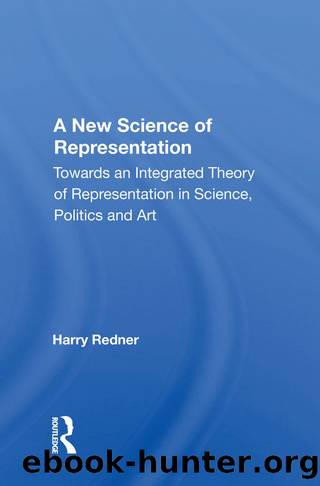A New Science of Representation: Towards an Integrated Theory of Representation in Science, Politics and Art by Harry Redner

Author:Harry Redner [Redner, Harry]
Language: eng
Format: epub
Tags: Political Science, History & Theory
ISBN: 9780813322117
Google: mBflAAAAIAAJ
Goodreads: 4945414
Publisher: Westview Press
Published: 1994-07-19T00:00:00+00:00
D. The Counter-Reformation and the Arts: Caravaggio, Monteverdi, Cervantes
Our case concerning Calvinism and Modernity seems to fall down completely the moment we turn to the arts. In the arts Calvinism, with its puritanism and initially destructive iconoclasm, had extremely deleterious effects in the Reformation period. During this time it was the counter-Reformation that played the leading role in artistic innovation, and the Jesuits were its most active agents. As the prime exponents of the techniques of propaganda -- the word comes from the then constituted Congregation for the Propagation of the Faith -- the Jesuits enlisted all the available arts for their holy cause. And in this respect, as contrasted with their failures in science, they were extremely successful, not only in winning over lost heretical souls, but also in creating new styles of art. What we now know as the Baroque came into being under their sponsorship; so much so that it is hyperbolically referred to as the Jesuit style. Their two churches in Rome, Vignola's Gesu and the St Ignatius designed by Father Grassi, Galileo's mortal enemy, were the initial examples in architecture of that style. The paintings in the interiors of these and other Baroque churches were further extensions of the Jesuit aesthetics.
However, it is not the Baroque that is for us typically modern, for in many respects it is a pre-modern style functioning on a mimetic basis. The decisively modern style -â also developed in this period and running alongside the Baroque -- has as yet received no name from aestheticians and historians of art. We might dub it the Representationalist style, for it fits in well with the whole mimetoclastic, representationalist tenor of Modernity. It also arose in the post-Tridentine counter-Reformation atmosphere of Catholic Europe, mainly in Hapsburg-dominated Italy and Spain. But not among the Jesuits; rather it was sponsored by the minor orders who were opposed to them in the internal bickering of the counter-Reformation Church, orders such as the Oratorians, the Theatines, the Capuchins and Augustinians. Like the Jesuits, these other orders also followed the explicit Tridentine doctrines and rulings on the arts, but they interpreted them differently. The Jesuits interpreted these dicta in a traditional neo-Aristotelian mimetic manner. This gave rise to the neo-classical, largely academic, arts of the great Catholic monarchies, above all that in France, which the Jesuits also supported, as well as to their preferred Baroque style; and though that differed from the neoclassical, it also fused with it in countless variations. The other orders tended much more towards a spiritual, mystical but, inner-worldly, pneumatic aesthetic which was conducive to the anti-mimetic and anti-classical art we have called Representational ist. It is this tendency which cradled the three great artists of counter-Reformation Europe, the founders of the modern arts: Caravaggio, Monteverdi and Cervantes. This occurred in the crucial period for Modernity from around 1600 till 1630 when modern science, too, was born, and modern politics only a little later in England.
The Representationalist style constituted itself in a complex relation of opposition to the other two great styles of the period, the neoclassical and the Baroque.
Download
This site does not store any files on its server. We only index and link to content provided by other sites. Please contact the content providers to delete copyright contents if any and email us, we'll remove relevant links or contents immediately.
What's Done in Darkness by Kayla Perrin(25500)
Shot Through the Heart: DI Grace Fisher 2 by Isabelle Grey(18219)
Shot Through the Heart by Mercy Celeste(18160)
The Fifty Shades Trilogy & Grey by E L James(17774)
The 3rd Cycle of the Betrayed Series Collection: Extremely Controversial Historical Thrillers (Betrayed Series Boxed set) by McCray Carolyn(13189)
The Subtle Art of Not Giving a F*ck by Mark Manson(12912)
Scorched Earth by Nick Kyme(11832)
Stepbrother Stories 2 - 21 Taboo Story Collection (Brother Sister Stepbrother Stepsister Taboo Pseudo Incest Family Virgin Creampie Pregnant Forced Pregnancy Breeding) by Roxi Harding(11040)
Drei Generationen auf dem Jakobsweg by Stein Pia(10217)
Suna by Ziefle Pia(10186)
Scythe by Neal Shusterman(9259)
International Relations from the Global South; Worlds of Difference; First Edition by Arlene B. Tickner & Karen Smith(8608)
Successful Proposal Strategies for Small Businesses: Using Knowledge Management ot Win Govenment, Private Sector, and International Contracts 3rd Edition by Robert Frey(8419)
This is Going to Hurt by Adam Kay(7695)
Dirty Filthy Fix: A Fixed Trilogy Novella by Laurelin Paige(6453)
He Loves Me...KNOT by RC Boldt(5804)
How to Make Love to a Negro Without Getting Tired by Dany LaFerrière(5378)
Interdimensional Brothel by F4U(5304)
Thankful For Her by Alexa Riley(5161)
